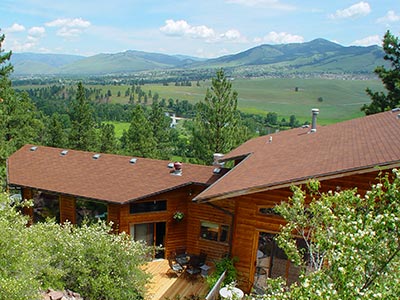One of the most delightful seasonal changes in Missoula, Montana occurs when the humming birds begin to arrive! Here at Blue Mountain Bed and Breakfast, we mark our calendars and put food up in mid-April. These little charmers mean that summer is just around the corner, or so we hope. This year, the little fellows must think they arrived a couple of months early because Montana welcomed them with a blanket of snow. I certainly don’t mean to be sexist when I throw the word fellow out there. However scientifically, certain species of male humming birds migrate a bit earlier than the females in order to secure their territories. Anyone who has spent some time around these birds can’t help but notice their territorial nature. It’s interesting to note that unlike many other migratory bird species, hummingbirds are solitary and do not migrate as part of a flock or group.
Here it is, the last day of April and the white cherry blossoms are covered over by a fairly heavy dusting of snow. In fact, Brady swept off more than an inch of snow from our decks
Well, welcome little wings of wonder. Welcome to our winter wonderland of snow that drapes the trees in white and now blankets the hidden green of our valleys. The sun is sure to shine down on us tomorrow.
Humming Bird Nectar Recipes:
To help our little friends sustain their energy, we use different sugar-water mixtures depending upon specific seasonal needs.
Blue Mountain B&B’s high energy mixture (early spring/fall): Our first Humming birds begin to filter through Missoula by the 3rd or 4th week of April, but most of them are just passing through on their way north. Whether they still have a distance to fly or are here to stay, they are exhausted… having lost as much as 25% of their body weight on the long trip. They can use all the help they can get, especially during a year like this one! During the first three weeks of the season, we put out a very high concentration of nectar, mixing 1 1/2 cups sugar with 2 cups of boiling water. Studies of flower nectar sugar content have found concentrations as high as 60% and as low as 6%. The lower concentrations are not enough to keep these little guys healthy and they have to feed far more often. (The traditional concentration of 4 to 1 is the minimum to sustain the birds and maximizes people’s viewing pleasure, as they must come and feed between 10 and 14 times an hour.) With the near 1 to 1 ratio we set out when they first arrive, we help them replenish their strength, spend more time building their nests, or give them some additional calories for that final destination if they are just stopping by. With such a high concentration, the birds need only feed between 4 and 6 times an hour. Starting in September or late August, we again fill the feeders with this high energy nectar to give them a good head start on their migration back south.
Blue Mountain B&B’s sweet, summer mixture: Our summer mixture is still heavier than the traditional, being 1 1/2 cups sugar to 4 cups of water. This gives the birds additional calories each time they feed so they do not have to feed as often. During the summer, there are many natural nectar supplies on the mountain as well. We have more than enough birds visiting our feeders for our viewing pleasure anyway, particularly considering the fact that so many of them are nesting, thus reproducing here on Blue Mountain. A big advantage to feeding a higher concentration even during the summer is that it serves a larger population of birds and the re-filling time and effort is cut way down.
A FEW FUN FLYING FACTS:
Most North American humming birds have seasonal migration patterns, wintering in the south and nesting in the north. The further a hummingbird must migrate, the sooner it must start its journey. Rufous hummingbirds have the longest migration of any hummingbird species and remember, there are over three hundred species world-wide. Only a few of those migrate, but still an impressive statistic. It’s amazing to think that many of the rufous migrate between Mexico and Alaska. This means they travel thousands of miles, not once, but twice in the same year! We are wishing these little guys lots of luck right now as we see quite a few passing through.
Knowing more about hummingbird migration patters helps backyard birders, like ourselves, anticipate when certain hummers will arrive. This is particularly important because they use up so much energy and we know from experience that blossoms and bugs can be pretty sparse this time of year. Interestingly enough, migrating hummers are often very predictable in their patterns, arriving at the same yards and then continuing on their journeys within days during the same calendar period each year. We count on them to brighten our warmer months, but most importantly, they may actually count on us! (On a side note, if you wish to know more about the banding of hummingbirds in our area, the following is an interesting link. Other hummingbird research-related topics are being conducted at The University of Montana. Enjoy!)
There are many controversial topics and myths out there related to hummingbird feeders. The majority of reading material states many beneficial aspects of feeding humming birds, as long as certain standards are put in place! Feeders can actually aide in the successful migration of these high metabolic bird burners. Feeders do not discourage hummingbirds from continuing their migration, they simply ensure that they have a food source that can be counted on. This is why placing feeders up in the early spring and continuing to keep them around in the fall is important. It is exactly during these times that enhancing the sugar content in their food is so important. It not only gives them the additional calories they need at this time, but the extra sugar helps prevent the solution from freezing.
To Perch or not to Perch? What about the “HOT” Montana topic of perch hypothermia? Well, my suggestion is to read several of the following, very interesting articles!
Another important topic of discussion is related to the use of red dye to attract humming birds? Could the spelling of dye be interchangeable with die is some cases? It’s something to think about carefully and read up on. Is red coloring really necessary in order to attract hummers? Remember, most feeders already have a splash of red on them which is usually more than enough. If it’s hard for you to resist putting out that eye-catching red water, then try adding some natural berry juice to the sugar water instead!
BEAR, Beware: remember to take your feeders in at night if you are in bear territory. Some bears can become habituated to the sight of feeders, day and night. In some areas, feeders may not be a smart choice at all.
A BIRD’S EYE VIEW:
Here in Montana, we begin welcoming back several different bird species in the early springtime. Blue Mountain Bed and Breakfast is registered as a backyard wildlife habitat. We have many forest birds that are here year round and others that come and go during the various seasons. Our location, high above the valley floor, literally offers guests a bird’s eye view of their own as well as many on-site birding activities. Not far from the bed and breakfast are many additional options for viewing birds in a variety of settings. Five Valleys Audubon offers an entire list of great Missoula birding locations. One of the closest locations is Maclay Flat, which is part of the Blue Mountain Recreation Area. Just down the valley, Lee Metcalf Wildlife Refuge is one of our favorite places to send guests. We often take the half hour jaunt ourselves to enjoy the wide variety of waterfowl and other treasures “hidden away” in this part of The Bitterroot Valley.
It doesn’t matter what time of year you visit Blue Mountain Bed and Breakfast, you are certain to see many birds. The spring, however is a particularly wonderful time for celebrating birds and everything that has to do with feathers. The Bitterroot Audubon Society has a calendar of events posted and Montana Audubon has a list of local as well as state-wide events. So bring your enthusiasm, your camera and your vacation plans to Montana. We will help ensure that your trip is both wild and wonderful here at Blue Mountain Bed and Breakfast!
We have many guest who spend time observing our various birds, but one summer in particular always comes to mind. Several years ago, a surgeon stayed with us for an entire week. He spent most of his vacation sitting on our front deck watching the many humming birds species feed! It’s a daily reminder to me that sometimes the most satisfying things in life are pure and simple.





